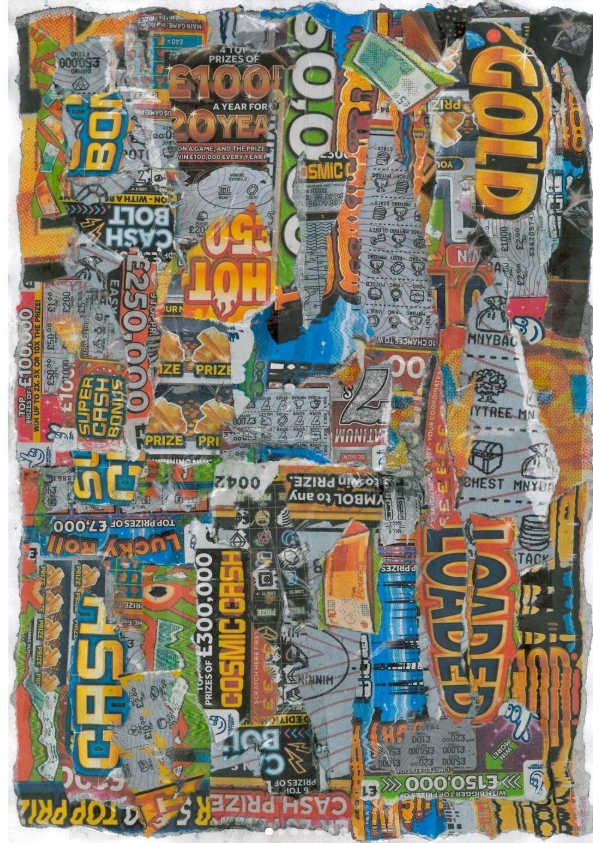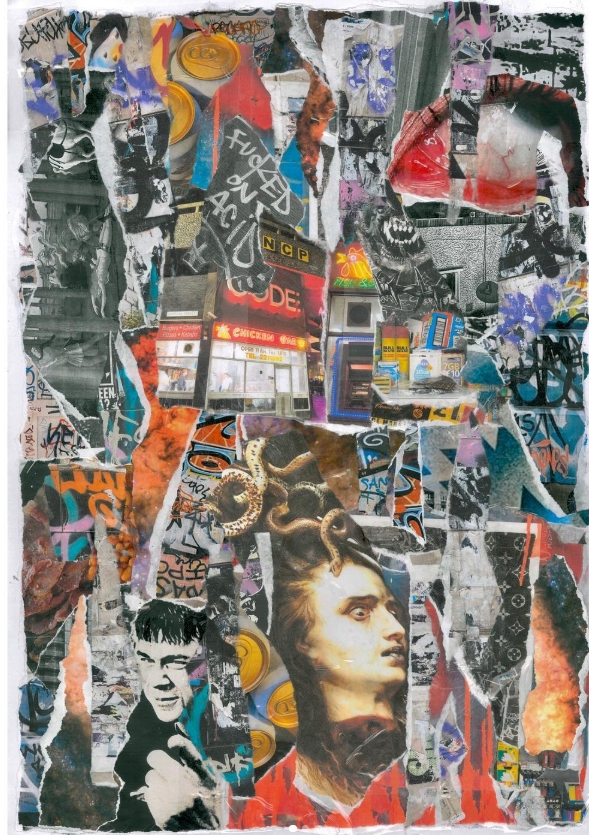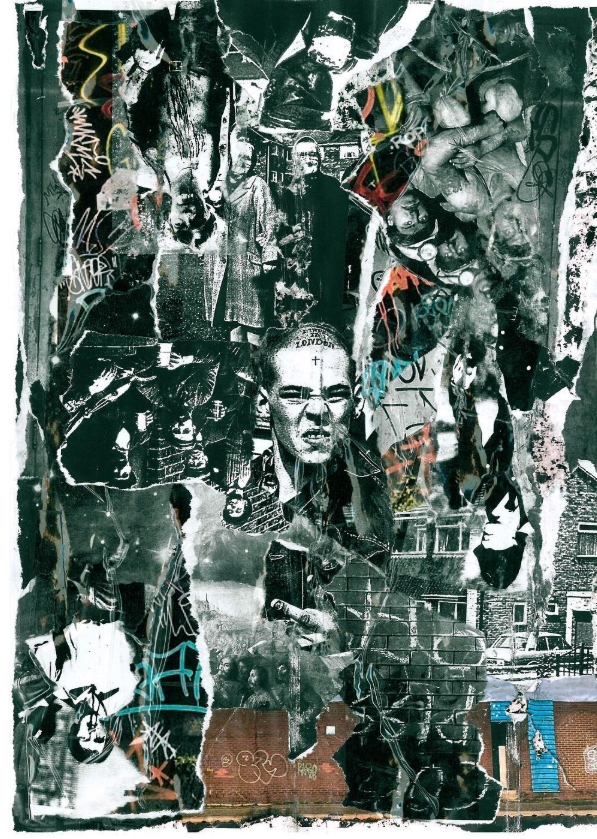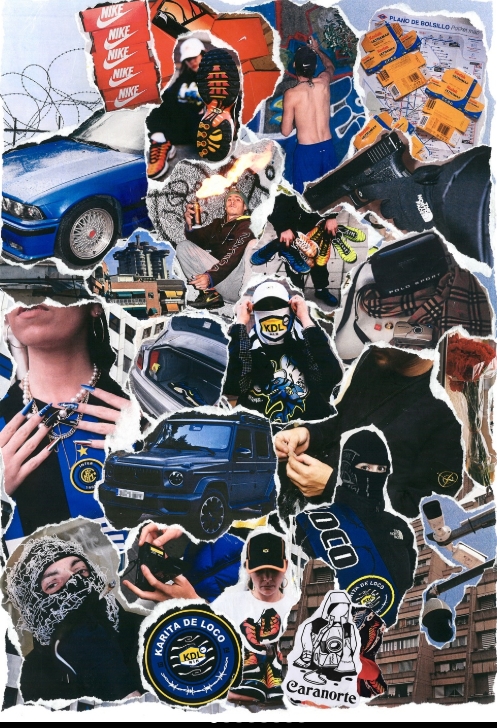MERGING A PIERCING OUTLOOK ON WORKING-CLASS LIFE WITH SHARP COMMENTARY AND VISUALLY CHAOTIC ART, SHEFFIELD’S MELVILLE RISES AS ONE OF THE CITIES MOST AUTHENTIC VOICES

PEDALO PHOTOGRAPHY
Sheffield’s gifted arts scene is teeming with talent. Meet one of its most authentic voices, Melville. His chaotic collage paintings combine social observation and humour to tell the story of life among working-class people and challenge boundaries. Every piece he does is a story, with humour combined and hard-hitting statements. I talked with Melville about his work and how his experience of life and philosophy have influenced this methodology.
This week, Melville’s new exhibition, The Symptoms of Social Observation, appeared in the city centre pub, Fagan’s. A chance encounter at Fagan’s led to the exhibition. “At the Kneecap after-party, I met lots of people, and I got chatting to James, the owner of Fagan’s, and we just knew we had to do something together. Things just came together naturally,” he explains. Walking into the opening night, Melville says, “It was really busy when I walked in, and it took me back a bit at first. The pub was packed out”. He appears surprised, but if you take a moment to observe his art, you’ll see its appeal immediately. I asked him about the meaning behind the exhibition. “We’re in social and political chaos. I want to explore how people cope with these struggles, whether it’s through vices like drinking, drugs, or any other means of escape, through my work. Even though I cannot be certain that my work will change the situation, we must capture and preserve these moments for future generations. Documentation matters, even if it doesn’t solve the problem. The goal is to make sure these stories and experiences are not forgotten.”



A new video that Melville created with Blood Shot Incorporated was also shown. I asked him about the short film, “The new video picks up where the last one ended, as a sequel for last year’s riveting ‘We Love What You’ve Done with the Place’ show. New work blends old video methods with greater spoken-word involvement, which allows for the luxuriant exchange of feeling and of thought. This visual choice suits the show’s overriding theme, which involves bringing old and new art forms together with a subtle layering of work on show. Several segments of the video were filmed at Fagan’s, which added that intimate and personal dimension to the overall narrative of the event.”
Melville has a catchy, unique way of marketing his work and exhibitions. “You see when a clickbait title gets you on YouTube? I do the same with exhibitions, so they’re not the same and they stand out,” he explains. For his first exhibition with Mondos, Melville created an event from the outset by referencing the Telegram drug dealer menu, with detailed, eye-catching photography that intrigued people. “I spoofed NHS no-reply texts too; actually shocked people. But in all honesty, that’s what smart marketing does. It’s amusing and interesting how these things come alive. I also creatively incorporated drug bags into my art promotion, and the moment I hand one to someone, their expressions are priceless. I love to watch their curiosity and surprise unfold as they realise the unexpected connection between my artwork and the bag in their hands. The looks on their faces tell a story that I thrive on.”



For Meville, the concept of addiction is nuanced. While he doesn’t identify with the typical struggles associated with the word, he acknowledges his compulsive tendencies. “Addiction is such a strong, almost dirty word, but I wouldn’t say I’ve struggled in the typical sense. It’s more like I’m compulsive, an obsessive thinker and collector. I used to collect bottle tops as a kid, then when I got older, some footy stuff that’s actually quite rare now, but that obsessiveness can be both a curse and a blessing. Sometimes, it drives me in positive ways. For example, when we’re working on projects for Bloodshot Art, we’ll spend six to seven hours on a Friday night filming. It’s exhausting, but it also makes me feel alive, like I’ve got purpose and drive. And it feels good to know we’re doing it for a reason.”
Melville’s ability to blend anarchic and intimate aspects with cultural observation remains so strong that it imbues moments and memories with depth and familiarity. His work is not about his personal imaginative life but a mirror for others to see themselves in. With his latest show opening, there is no doubt that his philosophy of bringing the personal and universal together remains central to what he does.
I asked him about where his inspiration came from and how he started. “Well, I’m a huge fan of The Libertines and Babyshambles. They were my favorite band when I was around 16. I used to read Peter Doherty’s books, such as Albion. They were photographs and collages, a visual journal, really rough and cut-and-pasted. That was really an inspiration for me. It was a rough, tactile thing, a bit like ideas written on masking tape. It planted a seed for the way I work today. And there, suddenly, my ideas started falling into place. I applied the same cut-and-paste visual style and blended that with a punk and grunge ethos in my work, including collages and, for example, making T-shirts with a raw DIY ethos. All these things, like raw imagery, nostalgia, and punk ethos, have driven my work. It’s really a blend of everything that I love.”

When I asked him where he sources his images, Melville told me, “With the imagery from the pieces, I mainly work with my own photographs because they retain the personal essence of the work. That being said, I also like using elements of nostalgia, clippings from vintage magazines, and references to ’90s pop culture. I wasn’t part of the rave and dance scenes of the 90s, but I love their aesthetic. I also add references from British popular culture, such as Vera and Jack from Coronation Street. The Irish link with my Grandad and mates like Brogeal, it’s all in there. It’s about bringing together pieces that are personal to me in a way that’s relatable to others. My work is deliberately everywhere; it’s a mix of a whole lot of various ideas and references. That’s the beauty of making it and, hopefully, engaging people. If they view it, I hope they’ll go, “Oh, I recognise that.” It’s about achieving that balance between personal and something that’s relatable.“

Activism also plays a significant part in Melville’s work. Although it doesn’t always take centre stage, he tackles subjects that resonate with him deeply. “I don’t want to be too didactic, but if something sparks my eye or I think that it’s something that’s interesting, I’ll do something about it.” With the borrowing of right-wing protest imagery from London, Melville has made unflinching statements through art that challenge divisive rhetoric and hate. His work addresses subjects like immigration and social tensions, creating bold statements that counter hate and fear.

“I don’t censor my tongue, never mind on touchy subjects,” says Melville. “People like Donald Trump and Elon Musk enjoy controversy, and I’m troubled that politicians are selling tainted ideas. I’ve grown up with politicians like Bill Clinton and Obama, with scandals and everything, always managing to carry themselves professionally. Consider that we elected a sex offender president. What does that teach kids?”
In addition to politics, Melville is also propelled by social issues, especially how social media influences perception. “Social media gives negativity a hundred times amplification. It’s terrible to see an old-school mentality hijacking something like Facebook where conversations turn hysterical,” he sighs. Despite such conflicts, however, Melville remains authentic, blending vulnerability with strength. “Negative feedback on the web gets me down occasionally, but I’ve learnt to ignore it.”.
Humour has also taken a prominent role in Melville’s recent work. Mixing realism with humour allows him to connect deeply with his audience. “That combination of realism and comedy can be incredibly potent. If you’re always serious, people tune out. Humour keeps them watching.”

Melville’s artistic process is also deeply personal. Reflecting on his past, he tells me, “We did not have much when I was growing up; times were tough on the council estate. Police were on the street most weeks, burglars, and drink and drugs as a way of living were just the way things were. Despite everything, my mother used to take my brothers up to Blackpool each year on a festive outing to view the Blackpool Lights. It wasn’t posh by any means. I mean, my mates were off to Florida, but there were moments that I have remembered, such as seeing the same families from one festive season to the next.” These moments underpin his commitment to the real, resonating through his depictions of working-class life.
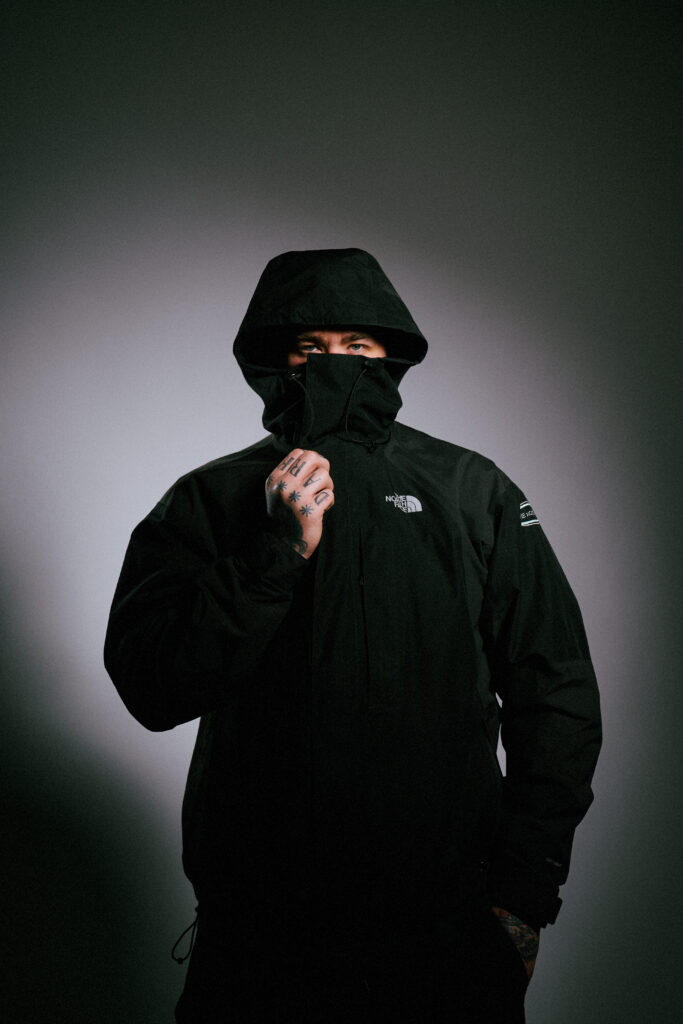


PEDALO PHOTOGRAGHY
Melville detailed how character serves him in his work, stating, “When I get into a character of a sort, I am released to do things I wouldn’t do ordinarily. I am more expressive, especially when I work. I was such a shy child in school that I did not want attention. But today, becoming a character amounts to checking off an imaginary bucket list.” This approach influences his work and makes him connect with the people. “It becomes as much about the character as the art. It makes it believable and personal, and not just me as an individual. People identify with that.”
Collaboration also builds on Melville’s ideas. “Other people’s work really nudges things in new directions or else improves on them. It’s satisfying, that’s for sure, whether that’s art, videos, or even character creation.” He explains, “Bringing a character’s personality, backstory, and universe together is interesting. It’s nice seeing people’s reactions. That mixture of character and art makes it special and interesting, but part of that’s sticking close to the original concepts.”
Looking at the passion-income trade-off, Melville admits, “Do I make a fortune doing that? Not necessarily. It’s not about money; it’s about leaving something in the universe that has meaning. That’s what keeps me going. I make some money on the commission side but still work full-time.”
In the long run, Melville further states, “It’s been crazy, so I’d like to restart and relive the experience again, photographing, creating new projects, and see where that will take me.”
From his humble background to his cultural critique, Melville’s trajectory is one of integrity and ambition. His ability to merge wit, criticism, and skill positions him as a genius artist who is not shy of challenging himself in each piece. I am looking forward to what he will do next.
The show runs on the walls of Fagans throughout April.
FAGANS
69 Broad Lane, Sheffield S1 4BS
FOLLOW
MELVILLE (@melville_the_third) • Instagram photos and videos
SHOP
STUDIO PHOTOGRAPHY BY Pedalo Photography (@p_e_d_a_l_o) • Instagram photos and videos
